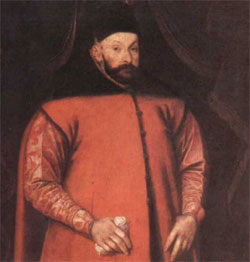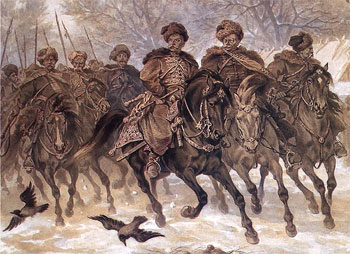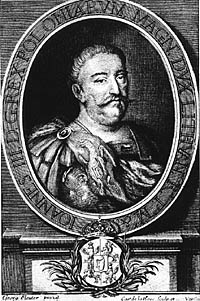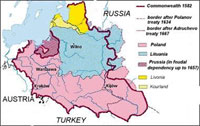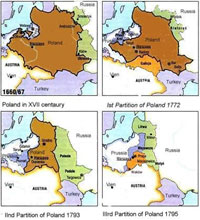- Articles Index
- Monthly Features
- General History Articles
- Ancient Near East
- Classical Europe and Mediterranean
- East Asia
- Steppes & Central Asia
- South and SE Asia
- Medieval Europe
- Medieval Iran & Islamic Middle East
- African History (-1750)
- Pre-Columbian Americas
- Early Modern Era
- 19'th Century (1789-1914)
- 20'th Century
- 21'st Century
- Total Quiz Archive
- Access Account
The Polish-Lithuanian Commonwealth
By TJK
Category: Early Modern: Political History
Birth of the Polish-Lituanian Commonwealth
The Elected Monarchy With the death of Zygmunt, in 1574, there was nobody who could legally convene the Seym. An "interrex" (Regent), the Archbishop of Gniezno, was appointed by the Senate and a special "Convocational Seym" was called which decided to let the "szlachta" (nobility) the elect a king in a free election. Prior to his coronation the king-elect had to swear to uphold the Constitution and all "szlachta" privileges. The first elected monarch was Henri d'Anjou, but he resigned half-way through the year in the hope of succeeding to the French throne instead. The second election winner was the Transylvanian Prince, Stefan Batory, who became one of Poland's most celebrated rulers, great in both war and peace. Batory carried out important reforms, encouraged further overseas trade and created the first regular Polish infantry by conscripting peasants from the Royal estates. Between 1579 and 1582 Batory came to the aid of Inflanty (Livonia) which has been attacked by the Muscovite Tsar, Ivan the Terrible. After a successful campaign and a brilliant victory at Pskov Batory accepted the Muscovite plea for peace; Livonia joined the Commonwealth and Poland was now recognised as the greatest power in Central Europe. After the unexpected death of Batory in 1586, the third election brought the Swedish crown prince, Zygmunt Waza, to the throne. Under his reign the Polish magnates (great lords) rose to a position of power and would eventually destroy Poland through their greed.. King Zygmunt III Waza decided to move the capital from Krakow to Warsaw, the junction of all major routes crisscrossing the Commonwealth. This was done in 1596.
Under Zygmunt III Poland waged wars of self-defence with Sweden, Russia, the Tatars, and the Turks. After his death the nobility elected Zygmunt's son -Wladislaw IV king (1632-48). Towards the end of this reign the warlike Cossacks in the Ukraine, who defended the southeastern frontier of Poland against the Ottoman Turks and Tatars, revolted, joined forces with the Tatars, and with their combined armies inflicted a severe defeat upon the Poles. But even worse times were in store for Poland under the succeeding rulers, Jan Kazimierz (1648-68) and Micha³ Korybut Wisniowiecki (1669-73). The Cossacks and Tatars made terrible ravages on the eastern frontiers of Poland. After that the Russians joined Cossaks , invaded the country and occupied Kiev, Smolensk, Polotsk, and Vilna. Then the Swedes, under Charles X Gustavus, conquered (1665) almost the whole of Poland; King Jan Kazimierz was compelled to flee to Silesia. In the autumn of 1655 the State, as such, ceased to exist. Lithuania and the Ukraine were under the power of the Tsar; Poland had been conquered by the Swedes; Prussia was occupied by the Brandenburgers. No one dared offer any resistance. But when the monks of Czestochowa repelled an attack of 2000 Swedish troops, the spirit of the nobles and magnates revived. Soon the Austria and Denmark joined the war against Sweden and after next 4 years Swedes were finally defeated. In 1658, at Hadziacz, an agreement between the King and the new Cossack Hetman, Wyhowski, was to enable Ruthenia to join the Commonwealth on equal terms with Poland and Lithuania but a further Cossack rebellion, in 1659, instigated by Muscovy and Polish involvement in war with Sweden, meant that the agreement bore no fruit and in 1667, by the treaty of Andruszowo, the Ukraine was divided evenly along the Dnieper between the Commonwealth and Muscovy. For the Polish Commonwealth this was a disaster since it weakened an important frontier area and left a discontented people open to manipulation by Poland's enemies. Jan II Sobieski
Later, in 1672. the Ottomans invaded the Commonwealth and imposed the treaty of Buczacz on the Poles by which Turkey occupied Podolia and the southern part of the Kiev region. In 1673, Hetman Jan Sobieski scored a splendid victory over the Ottoman Turks at Chocim which, though not changing the provisions of the treaty, enabled Sobieski's election to the throne. 1674-1696 heralded the of Jan III Sobieski, a great military leader who had been given by Turks the nickname of the "Fearful Lion of the North." Unable to break into Europe through Poland, the Ottomans Turks invaded Hungary and Austria in 1683 and swept all before them. 130,000 Turks besieged Vienna and threatened to overpower Europe. Sobieski marched on Vienna, sent the "Hussaria" into their last great charge and took the Ottomans unawares. It was a turning point in history. The Decline of Poland In 1697 the Elector of Saxony, Augustus, was elected King. From 1700 - 1721, Augustus II allied himself with Russia and became involved in war with Sweden for control of the Baltic (the Great Northern War). Poland became a battlefield and the Polish throne the prize. In 1704 Sweden won, Augustus was removed and the Voivode of Poznan, Stanislaw Leszczynski, was elected in his place. In 1709 the Russians defeated the Swedes at Poltava and Augustus was returned to the throne. Conflict between Augustus and the Seym almost ended in civil war in 1717, only prevented by a Russian offer of mediation. Russian troops surrounded the chamber where the deputies met, they were denied the right to speak whilst the Russian "mediator" dictated the Russian " solution". This Seym became known as the "Dumb Seym" and the Republic became little more than a Russian client state; this was the start of the Russian "Protectorate". On Augustus' death, in 1733, Leszczynski was again elected King but the Russians interfered by sending in an army and rerunning the election; Augustus' son, Frederick Augustus, was elected. Poniatowski
The Partitions of Poland 1772 - 1795 Taking advantage of a now weakened Poland, Prussia, Russia and Austria agreed to annex parts of the country in 1772. The Commonwealth lost 733,000 sq.km (23%) of her former territory and 4,500,000 of her population; To give the crime some legality the Seym was forced to ratify the partition in 1773, despite the resistance of some Deputies, led by Tadeusz Rejtan. Despite the disaster of this first partition, Poland underwent a national revival in 1773, thanks to the efforts of Poniatowski. The first step was the creation of the "Komisija Edukacji Narodowej" ("Committee of National Education"), the first Ministry of Education in Europe. Hundreds of schools were founded and the standard of education was raised. Partitions of Poland Taking advantage of Russia's involvement in a war against Turkey, the King launched a reform programme (1788-1792) and the task was carried out by the "Four-Year" or "Great Seym" which established a new Constitution; the Constitution of the Third of May. Established in 1791, under this Constitution the "liberum Veto" was abolished and a majority rule introduced, and personal freedoms guaranteed to all the people. The Constitution was hailed in the United States, England and France, but was seen as a threat to the absolute rulers of Prussia, Austria and, especially, Russia. So, in 1792, at Russia's instigation a handful of magnates led by Ksawery Branicki, Szczesny Potocki and Seweryn Rzewuski betrayed the Commonwealth and formed the Confederation of Targowica against the new Constitution and then "asked" for help. Russian troops crossed the borders and war broke out. The King's nephew, Joseph Poniatowski and Tadeusz Kosciuszko, a veteran of the American War of Independence, put up heroic resistance but small polish army have been finally defeated. Many patriots were forced to flee. In 1793 Russia and Prussia signed the Second Partition Treaty, seizing more than half the country and about four million more of the population. The last Seym of the Commonwealth, which met at Grodno, was forced to legalise the partition and abolish most of the reforms of the "Great Seym". The Poles, resolved to defend their independence, rose, under the leadership of Tadeusz Kosciuszko, against Russia and Prussia. Victorious over the Russians at Raclawice (4 April, 1794), he occupied Warsaw, but was defeated and taken prisoner at Maciejowice (10 October, 1794). The revolt had miscarried: Russia, Prussia, and Austria divided among them the rest of the Polish kingdom. The king abdicated. And thus the third and last partition of Poland was effected (1795). List of Kings Zygmunt August 1548-1572 Henri de Valois 1573-1574 Stefan Batory 1576-1586 Zygmunt III Waza 1587-1632 Wladislaw IV Waza 1632-1648 Jan Kazimierz Waza 1648-1668 Micha³ Korybut Wisniowiecki 1669-1673 Jan III Sobieski 1674-1696 August II 1697-1733 Stanis³aw Leszczyñski 1704-1709 & 1733-1735 August III 1733-1763 Stanislaw August Poniatowski 1764-1795 |


